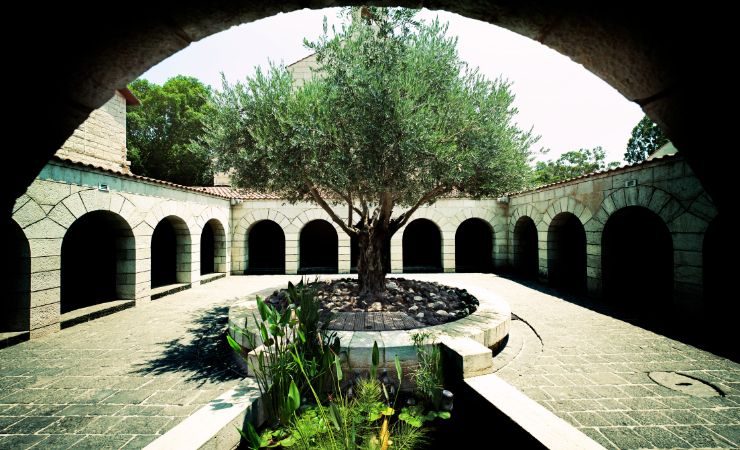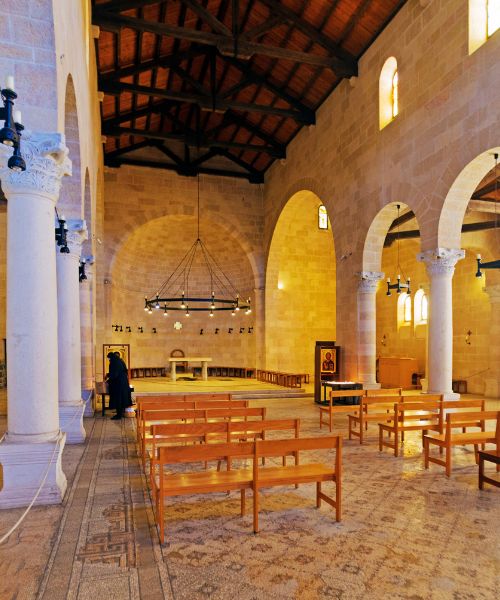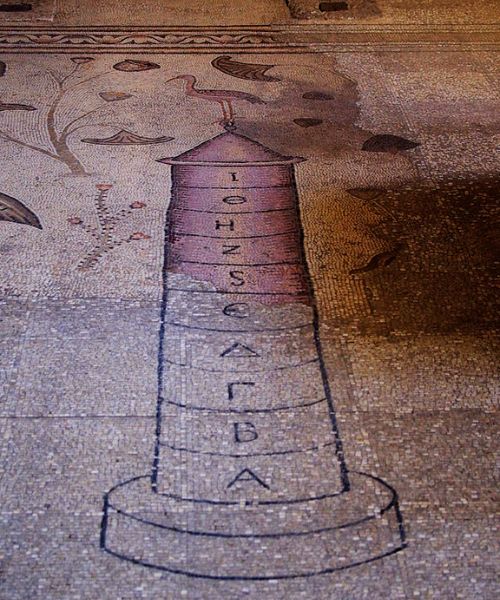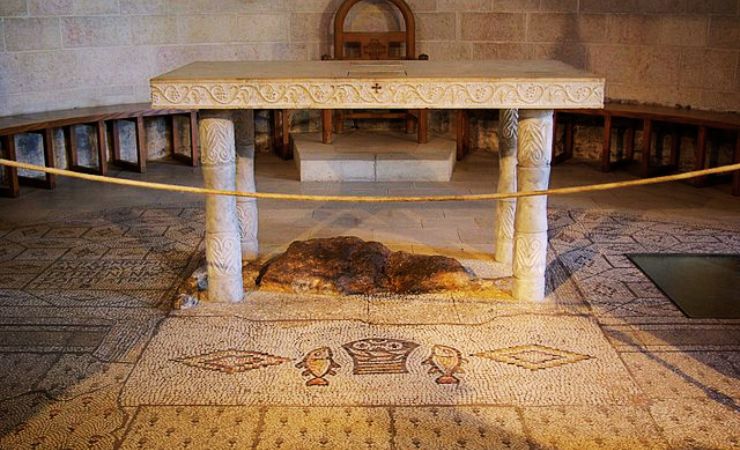The The Church of the Multiplication: Serving Loaves and History
Introduction
Located on the North shore of the Sea of Galilee, the Church of the Multiplication, holds profound significance as the commemorative site of Jesus’ miraculous feeding of the five thousand, making it a cornerstone of Christian pilgrimage.

Location
Unfolding on the northwestern shores of the Sea of Galilee, the Church of the Multiplication is a picturesque sanctuary just south of Capernaum. The verdant tranquility of Tabgha, provides a serene backdrop to this sacred monument of Christian faith.
Biblical Context
The Church of the Multiplication commemorates an event steeped in profound divine intervention as narrated in the New Testament. Specifically, it pays homage to the miracle of the loaves and fishes as outlined in the Gospels of Mark, Matthew, Luke, and John (6:1-14). This iconic event saw Jesus Christ feed a multitude of five thousand men, not counting women and children, with just five loaves of bread and two fish.
The Church of the Multiplication through the Ages
Early Beginnings
In the 4th century CE, the first known chapel was constructed at the site. Reflecting the architecture of the era, it was likely a small, single-room structure, serving as a place of worship and commemoration of the feeding miracle. The Spanish pilgrim Egeria, who documented her travels to holy places in the late 4th century, who wrote: “grassy field which has sufficient hay and many palm trees and nearby seven springs..”. The site around the church looks quite similar, to this day.”
The Byzantine Era
The first recorded chapel was constructed in the early 5th century under the auspices of the Byzantine empire. The chapel was modest, but noteworthy for its intricate floor mosaic. Over time, the humble chapel blossomed into a significantly larger complex, culminating in a grand basilica around the late 5th century.
The church’s story and structure is intertwined with one of the most significant ancient trade routes – the Via Maris. This critical trade route connected the old civilizations of Egypt, Syria, and Mesopotamia, coursed along the Mediterranean coast, then cut across the land of Israel, hugging the shoreline of the Sea of Galilee. As the Byzantine era dawned, the Church of the Multiplication emerged in the vicinity of this bustling trade highway. The proximity to the Via Maris provided the church with an influx of worshipers but it also posed a unique challenge to the expanding basilica. The proximity of the trade route dictated the church’s physical boundaries, confining its northward expansion.
The Church’s Revival
After suffering destruction at the hands of Persian invaders in the 7th century, the church lay in ruins for over a millennium. It wasn’t until the end of the 20th century, in the 1980s, that the site was meticulously restored by the Benedictine order, with the new church built over the preserved remnants of the Byzantine basilica.
The Current Church
In the wake of the 7th century CE destruction, the basilica at Tabgha lay in ruins for centuries. The turn of the tide came in the 20th century.
The initiative to rebuild the Church of the Multiplication began in the 1980s. The new church, spearheaded by the German Association of the Holy Land and the Benedictine monks, was erected on the exact footprint of the former Byzantine basilica, honoring the site’s sacred past.
The current Church of the Multiplication is a faithful reflection of the Byzantine basilica that once stood at the site. The structure follows a traditional basilica layout, featuring a central nave flanked by two aisles. The interior space is demarcated by a line of eight columns, replicating the layout of the Byzantine church.
Upon entering the church, visitors find themselves in a serene, beautifully lit courtyard, offering a space for quiet contemplation before proceeding into the nave. Here, the atmosphere is one of tranquil reverence, accentuated by the soft glow filtering through stained glass windows. The primary draw, however, lies underfoot. The church was deliberately constructed to showcase the exquisitely preserved 5th-century floor mosaics.
At the heart of the basilica, behind the altar, lies the focal point of the entire complex: the Rock of the Multiplication. This is traditionally believed to be the spot where Jesus blessed the loaves and fish before the miracle.



Archeological findings
- The 5th Century Mosaic Floor: Unearthed beneath the modern church’s structure, a vibrant Byzantine-era mosaic depicts the miracle of the loaves and fishes. Significantly, the only two fish flanking a basket containing only four loaves of bread—possibly indicating the fifth loaf is metaphorically ‘on the altar.’
- The Nile Mosaic: A fascinating mosaic depicting exotic birds, plants, and a Nilometer—an ancient device for measuring the Nile River’s level. The popularity of Nile imagery in mosaics during this period, echoed in places like Sepphoris and Beit She’an, and throughout the Roman empire, was more than aesthetic. They were synonymous with abundance and affluence, akin to the Nile’s flood levels symbolizing a good harvest.
Sources and Additional Reading
Wikipedia – Church of the Multiplication
Israel by Locals – Church of the Multiplication of the Loaves and Fish

Nearby Sites
- The Church of the Primacy of Saint Peter: Traditionally believed to be where Jesus reinstated Peter as the chief among the Apostles.
- Capernaum: Also known as ‘The Town of Jesus,’ it was here that Jesus spent a significant period of his ministry, and where many miracles were performed.
- Mount of Beatitudes: A short drive uphill from the church, is traditionally believed to be the location of Jesus’s ‘Sermon on the Mount.’ At the top of the mount is the Franciscan, Church of Beatitudes, constructed by architect Antonio Barluzzi.
- Kursi National Park: On the eastern shores of the Sea of Galilee, this park houses the remains of a Byzantine monastery and is linked to the miracle of the ‘Swine of Gergesa.’
- Bethsaida: Ancient remains of this city, once a fishing village and birthplace of several of Jesus’s disciples.



